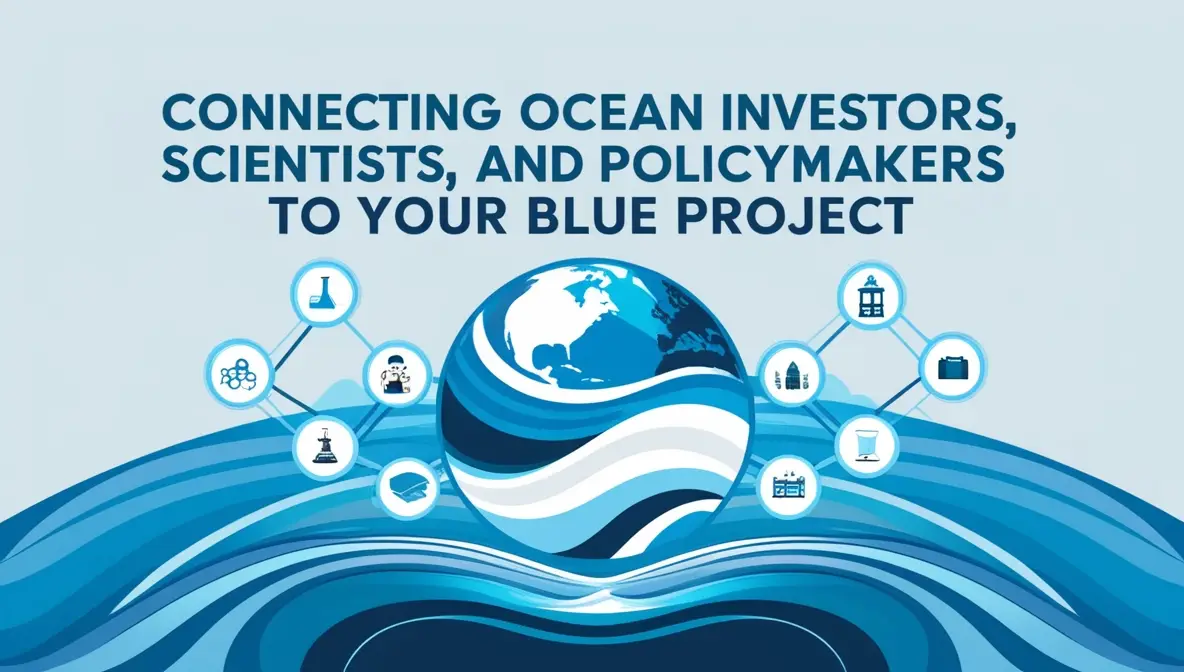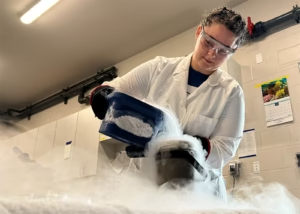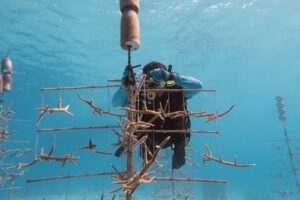by David FreedmanCoral Reef Conservation and Biodiversity Awareness | Early Career Ocean Professional (ECOP)
For startups, nonprofits, and NGOs working in the blue economy, building connections with investors, scientists, and policymakers is essential for success. These stakeholders bring different but complementary strengths: investors provide capital, scientists offer critical research and innovation, and policymakers shape regulatory frameworks.
By effectively engaging each of these groups, blue economy projects can scale sustainably, attract investment, and align with national and global ocean conservation goals.
Here, we outline key strategies, metrics, and milestone examples to build meaningful collaborations that drive blue economy success.
Step 1: Engaging Investors Through Impact Metrics and Financial Viability
Investors in the blue economy are not only looking for financial returns but also seeking impactful, scalable solutions that align with environmental and social goals. To attract these investors, organizations need to demonstrate both the financial viability and environmental impact of their project.
Key Metric: Return on Impact (ROI)
- This metric assesses the financial return on investment relative to the environmental or social impact generated. A higher ROI demonstrates that the project can deliver both profitability and measurable benefits to ocean ecosystems.
Example: An NGO working on ocean plastic reduction could set an initial goal of collecting 500 tons of plastic waste, aiming to generate $1 million in revenue through partnerships with recycling companies. After achieving this, the NGO can aim to double its impact, collecting 1,000 tons and increasing revenue to $2 million. This milestone approach demonstrates both scalability and impact, proving to investors that their funds contribute to measurable change.
Case Study: The Circulate Capital Ocean Fund (CCOF) invests in companies working to reduce ocean plastic pollution by funding scalable ventures that demonstrate clear impact and financial viability. By meeting impact milestones like waste reduction and revenue growth, CCOF-backed projects attract further investment and expand their environmental reach.
Step 2: Partnering with Scientists to Drive Innovation and Credibility
Scientific research is crucial for the blue economy, particularly in sectors like sustainable fisheries, coral reef conservation, and marine renewable energy. Collaboration with scientists not only drives innovation but also provides credibility, which is attractive to investors and policymakers alike.
Key Metric: Research Collaborations per Year
- This metric measures the number of active partnerships with research institutions, indicating the project’s commitment to scientific rigor. More collaborations often suggest robust innovation and scientific endorsement.
Example: A marine conservation startup could set a goal to establish partnerships with at least three marine biology institutes within the first year. By year two, the startup could aim to publish joint research findings on coral restoration with these institutions, enhancing its credibility and attracting more investor interest.
Case Study: The Coral Restoration Foundation collaborates with scientists from the University of Miami and the Florida Keys Marine Sanctuary to conduct joint research on coral resilience. This scientific backing strengthens the foundation’s restoration efforts, attracting investors who value evidence-based approaches to ecosystem rehabilitation.
Step 3: Engaging Policymakers to Secure Supportive Regulations and Public Funding
Policymaker support is vital for creating an enabling environment for blue economy ventures. Engaging with government bodies can help secure grants, ease regulatory barriers, and foster public-private partnerships that allow projects to thrive.
Key Metric: Policy Endorsements Secured
- This metric measures the number of policies or regulations that endorse or support the project. Endorsements from government agencies signal strong support and can make the project more attractive to both private and institutional investors.
Example: A startup working on offshore wind energy might set a goal to gain one policy endorsement or support from a coastal state government within the first year. By year two, the startup could work with policymakers to establish favorable permitting policies, enabling it to scale up its installations.
Case Study: The European Marine Energy Centre (EMEC) in Scotland collaborates with policymakers to test and develop tidal and wave energy projects. These partnerships have not only accelerated EMEC’s innovation but have also attracted private investors, demonstrating how policy support can open doors for blue economy ventures.
Step 4: Building Cross-Sector Partnerships to Amplify Outreach and Funding
To maximize their impact, blue economy projects should seek to build networks that bring together investors, scientists, and policymakers under a common goal. These cross-sector partnerships enable greater resource pooling, shared expertise, and collective impact, creating a more supportive ecosystem for blue economy growth.
Key Metric: Cross-Sector Partnerships Established
- This metric tracks the number of partnerships that span multiple sectors, such as joint ventures with research institutions, government agencies, and private investors. A growing number of partnerships signals a solid foundation for sustainable growth.
Example: An NGO working on mangrove restoration could aim to establish partnerships with at least two research institutions, one government environmental agency, and one corporate investor within its first year. By year three, it could aim to expand its network to include international development organizations, thus attracting global attention and resources.
Case Study: The Blue Natural Capital Finance Facility (BNCFF) facilitates multi-sector partnerships between environmental NGOs, government bodies, and private investors, providing a collaborative framework that attracts diverse funding sources and technical support for marine conservation projects.
Step 5: Demonstrating Transparency to Build Long-Term Stakeholder Trust
Transparency in reporting environmental and financial performance builds trust with investors, scientists, and policymakers. By setting clear goals and openly communicating progress, blue economy projects can foster strong relationships with these stakeholders and gain their long-term commitment.
Key Metric: Transparency Score (based on regular, audited reporting)
- This metric measures the frequency and quality of the project’s financial and impact reports. A high transparency score signals reliability and accountability, making the project more attractive to stakeholders.
Example: A blue economy startup could set an initial goal of producing quarterly impact and financial reports, with the first-year target being a full external audit of these reports. By the third year, it could aim to provide real-time data on key metrics through a digital dashboard, enhancing transparency for all stakeholders.
Case Study: The Ocean Cleanup organization provides transparent updates on its progress in ocean plastic removal, publishing detailed data and financial reports. This transparency has built strong stakeholder confidence, attracting both public and private funding.
Step 6: Creating Dedicated Communication Channels for Continuous Engagement
Establishing dedicated communication channels with investors, scientists, and policymakers can streamline collaboration and build stronger stakeholder relationships. These channels keep stakeholders engaged, informed, and supportive as the project progresses.
Key Metric: Stakeholder Engagement Rate (e.g., participation in quarterly meetings, newsletters)
- This metric assesses how actively each stakeholder group is engaged in project updates and activities. A higher engagement rate indicates strong stakeholder interest and ongoing commitment.
Example: An NGO focused on marine protected areas could set a goal to establish quarterly stakeholder meetings, sharing project updates and upcoming milestones. Within two years, it could introduce a digital newsletter, targeting a 75% engagement rate among investors, scientists, and policymakers.
Case Study: Wildlife Conservation Society maintains robust communication channels with government bodies, scientists, and donors through its digital updates and annual summits. This approach keeps stakeholders engaged, informed, and invested in WCS’s marine conservation efforts.
Building a Thriving Ecosystem for Blue Economy Success
Connecting ocean investors, scientists, and policymakers to your project is essential for long-term success in the blue economy.
By demonstrating impact and financial viability, leveraging scientific credibility, securing policy support, building cross-sector partnerships, maintaining transparency, and fostering continuous engagement, organizations can create a thriving ecosystem that attracts resources, fosters innovation, and drives positive change.
As Ove Hoegh-Guldberg, a renowned ocean scientist, once said: “To protect the ocean is to invest in our own future.”
By bringing together investors, scientists, and policymakers, blue economy projects can play a pivotal role in securing a sustainable future for both the oceans and help grow it’s economy.
Sources:
- Circulate Capital Ocean Fund. “Investing in Solutions to Ocean Plastic Pollution.”
- Coral Restoration Foundation. “Science-Driven Coral Conservation.”
- European Marine Energy Centre. “Accelerating Marine Renewable Energy Development.”
- The Ocean Cleanup. “Restoring the Ocean’s Health Through Transparency.”
- Wildlife Conservation Society. “Connecting Stakeholders for Marine Conservation Success.”




